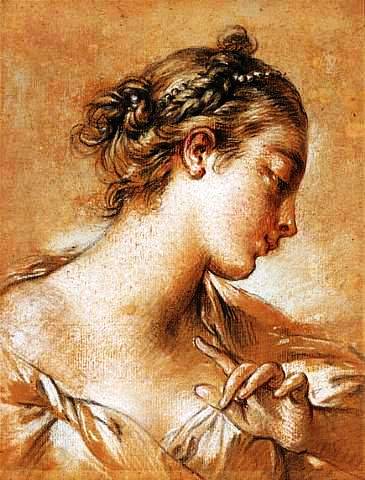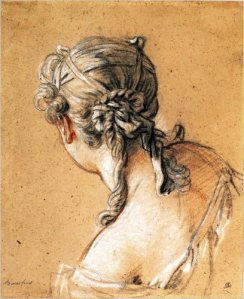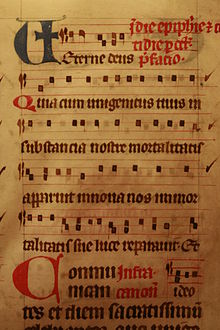Tags
commedia dell'arte, d'Alembert, Diderot, La Serva padrona, Pergolesi, Querelle des Bouffons, Rameau, Stabat Mater

Stabat Mater, by William-Adophe Bouguereau* (Photo credit: Wikipedia)
Giovanni Battista Pergolesi (4 January 1710, in Jesi – 16 or 17 March 1736, in Pozzuoli), whose real name was Draghi, was an Italian composer, an excellent violinist and an organist. His family had moved from Jesi to Pergola, hence the name Pergolesi.[i]
Pergolesi died at the age of 26, probably of tuberculosis. But, between the time he started to study music, c. 1720, at the Conservatorio dei Poveri at Naples and his death, a mere sixteen years had elapsed. Mozart (27 January 1756 – 5 December 1791) died at a young age, 35, as did Schubert (31 January 1797 – 19 November 1828), who died at the age of 31.
In 1732, Pergolesi was appointed maestro de cappella to the prince of Stigliano, and, in 1734, he became deputy maestro de cappella, in Naples.
Sacred Music
Pergolesi was such a fine violinist and composer that, during his own life time, he was called the “divine,” by his followers. For musicologists, he is, first and foremost, the composer of the Serva padrona (“The Maid turned Mistress”), an opera buffa, or comic opera, composed in 1733. But if we exclude the circumstances that made his opera buffa and its composer famous, he is remembered mainly for his Stabat Mater, a sacred work he composed the year he died, in 1736.
The Stabat Mater was commissioned by the Confraternità dei Cavalieri di San Luigi di Palazzo, a group of pious and generous gentlemen. However, by 1736, Pergolesi had also written a Mass in F and his long and very mature Magnificat in C major. In Naples, he composed his Mass in D and his celebrated Stabat Mater.
Pergolesi also composed instrumental music: a violin sonata, a violin concerto, a concerto for flute, and other instrumental works. But doubt lingers concerning the authorship of some of the instrumental music attributed to him. Investigators are at work.
Operas
So, we now come to his operas. In Naples, Pergolesi had written Lo frate’nnmmorato, an opera buffa (comic opera). But he had also composed an opera seria (serious) entitled Il Prigioner superbo (The Proud Prisoner), a work which contained a two-act comedia buffa, La Serva padrona (The Maid turned Mistress). It is this opera buffa that made him a celebrity, albeit posthumously.
La Serva padrona, an intermezzo, was in no way subversive It had been composed to a libretto (the words) by Gennaro Antonio Federico who gleaned some of his material from a play by Jacopo Angello Nelli. In fact, not only was it not subversive, but it had already been performed in Paris, on October 4th, 1746, without attracting much attention.
La Serva padrona and the “Querelle des Bouffons” (video, here and below)
But in 1752, circumstances had changed. For one thing, the August 1st, 1752 performance of La Serva padrona (“The Servant turned Mistress”) took place at the most elegant venue in Paris: the Opera, or the Académie royale de musique. Moreover, it was performed before an élite audience. As a result, this one performance led to an unpredictable two-year quarrel (1752-1754) that opposed the most brilliant minds among the “lumières,” including d’Alembert, Diderot and Jean-Jacques Rousseau (28 June 1712 – 2 July 1778). But Rousseau is the person who threw the first stone, except that the “querelle” was a paper war.
Sense and Sensibility
The “Querelle des Bouffons,” or “Quarrel of the comic actors,” was indeed a paper war. It took the form of an exchange of letters and pamphlets, totalling sixty-one documents, all written by the most erudite “philosophes” of the French Enlightenment, not to mention a bevy of salonniers and salonnières. It was the event of the century, prior to the French Revolution.
—ooo—
Yet, it would not be altogether fair to give circumstances the leading role in the “querelle.” Pergolesi’s Serva padrona is an opera buffa, but it had been composed by Pergolesi, the “divine,” and talent supersedes genre. In other words, the performance of the Serva padrona was a catalyst in the “querelle,” but it is unlikely that a lesser opera buffa would have unleashed a fury. No greater compliment was ever paid Pergolesi. The Serva padrona was so delightful an opera buffa, that Geneva-born French encyclopédiste and musician Jean-Jacques Rousseau could use it to oppose French opera.
There had long been tension between Italian music and French music, then dominated by Jean-Philippe Rameau (25 September 1683 – 12 September 1764), the author of a Treatise on Harmony, published in 1722. As you know from an earlier blog, this treatise remains authorative. But although the “querelle ” could be considered as yet another battle in the war between French “ramistes,” the name given supporters of Rameau, on the one hand, and lovers of Italian opera and commedia dell’arte, on the other hand, it may be best to suggest that it opposed reason and sentiment, or sense and sensibility.
The supremacy of reason had been disputed by Pascal, among other thinkers, but since the publication of Descartes‘s Discours de la méthode, in 1637, the fashion for sentiment had suffered. Although Voltaire (b. François-Marie Arouet), 21 November 1694 – 30 May 1778, was extremely witty and entertaining, as a philosopher, he was an advocate of reason. Be that as it may, Rousseau rather enjoyed shedding a tear or two at the opera, as did a substantial number of his companions involved in the “querelle.”
* * *
In short, because Pergolesi’s Serva padrona was exquisite in its genre, it was the perfect weapon in a war against “ramistes,” which means that if sentiment and the Italians won that particular battle, the “querelle” also constituted abundant praise of Pergolesi’s talent. Without this weapon of choice, the Serva padrona, there may never have been a “Querelle des Bouffons” for sheer lack of ammunition.

Three Gentlemen and Pierrot
Claude Gillot (28 April 1673 – 4 May 1722)
YouTube allows one to listen to and to view the Serva padrona in its entirety, but Pergolesi’s Stabat Mater remains the centrepiece. I hope you enjoy listening to some music composed by a forever young Pergolesi who died in poverty in a Franciscan monastery, at Pozzuoli, near Naples, aged 26.
* * *
(please click on the titles to hear the music)
- The “Querelle des Bouffons” (comments in Italian about the commedia dell’arte)
- Pergolesi – Pergolesi Concerto per Violino I Mov.mp4
- Pergolesi – Pergolesi Concerto per Violino II.mp4
- Pergolesi – Konzert G-Dur für Flöte und Orchester 1
- Pergolesi – Konzert G-Dur für Flöte und Orchester 2
- Pergolesi – Konzert G-Dur für Flöte und Orchester 3
- Pergolesi – Laudate pueri Dominum (2)
- Pergolesi – Salve Regina in C minor (1)
- Pergolesi – Stabat Mater, Jaroussky & Gens
- Pergolesi – Magnificat in C Major
- Pergolesi – La Serva padrona -II
[i] “Giovanni Battista Pergolesi”. Encyclopædia Britannica. Encyclopædia Britannica Online. Encyclopædia Britannica Inc., 2011. Web. 20 Dec. 2011. <http://www.britannica.com/EBchecked/topic/451597/Giovanni-Battista-Pergolesi>.
“Giovanni Battista Pergolesi”. Encyclopædia Britannica. Encyclopædia Britannica Online. Encyclopædia Britannica Inc., 2013. Web. 06 déc. 2013.
<http://www.britannica.com/EBchecked/topic/451597/Giovanni-Battista-Pergolesi>.
performers: London Symphony Orchestra, 1985 Margaret Marshall, Soprano; Lucia Valentini Terrani, Contralto conductor: Claudio Abbado
 © Micheline Walker
20 December 2011
5 December 2013 (2nd edition)
WordPress
Scène,
Claude Gillot
© Micheline Walker
20 December 2011
5 December 2013 (2nd edition)
WordPress
Scène,
Claude Gillot








